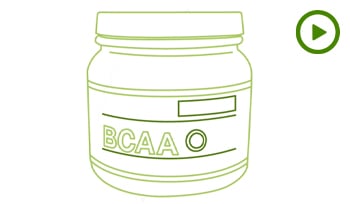Taurine Health Benefits
DISCLAIMER:This blog does not intend to provide diagnosis...
- In this article:
- What Is Taurine?
- Food Sources of Taurine
- Health Benefits of Taurine
- Takeaway

What Is Taurine?
Taurine is an important amino acid in humans.1 Amino acids are molecules most often utilized in the body and linked in chains to form proteins. However, taurine is not used in proteins. It has special functions, including:
- Forming bile salts that promote the absorption of fats (lipids) and elimination of cholesterol, hormones, and toxins through feces.
- Maintaining the proper electrical charge of cells by promoting hydration and electrolyte balance and stabilizing cell membranes.
- Critical to proper nerve and muscle function.
- Playing a central role in the regulation of internal cellular function.
- Acting as a major antioxidant and anti-inflammatory agent in the body.
- Supporting immune system health and function.
Food Sources of Taurine
Taurine’s name comes from the Latin word taurus, meaning bull or ox, because it was first isolated from ox bile in 1827. Taurine is also found in relatively high concentrations in bull testicles. However, the main dietary sources of taurine are fish and other seafood, meat, and dairy.
Plant foods are generally low in taurine. As a result, people consuming a vegan diet typically have lower body levels of taurine. People who routinely eat good taurine sources have a typical daily intake of 125-175 mg daily. It is near zero in a vegan diet, while a lacto-ovo vegetarian diet that includes dairy products and eggs provides about 15 mg per day of taurine.1
Taurine is also made in the body primarily by the liver, where it is synthesized from cysteine, another amino acid. A healthy adult manufactures 50 to 125 mg of taurine per day. Presumably, less is manufactured if the dietary intake of taurine is higher. The liver will also make less taurine if a person is under stress or dealing with a health challenge like poor liver function, obesity, diabetes, infection, and others. In addition, infants and children are predisposed to low taurine levels because they do not sufficiently manufacture taurine (especially premature newborns).1
Because taurine is such an important amino acid in the body, along with the fact that in many situations, body manufacture may not provide all the taurine the body needs, taurine is considered a conditionally essential amino acid. A conditionally essential nutrient is one where the body, when healthy, can usually manufacture sufficient levels. Still, when the body does not make enough, getting adequate intake levels through diet or supplementation is critical. Other conditionally essential nutrients include coenzyme Q10, alpha-lipoic acid, carnitine, and glucosamine.
Health Benefits of Taurine
There are a lot of urban legends about taurine, spread primarily because it becoming a popular ingredient in energy drinks. However, there is also a lot of scientific validation for its important role in promoting health and energy.
For example, taurine is essential to the health of mitochondria, the energy-producing compartments in cells. Low mitochondria function is associated with accelerated aging, impaired metabolism, poor cardiovascular health, and decreased physical and mental energy. Various experimental studies have shown that taurine supplementation supports mitochondrial function.2 Human clinical trials in subjects with impaired mitochondrial function have also shown taurine produces considerable benefit to mitochondrial function.3 These results suggest that some of the health benefits observed with taurine supplementation result from supporting energy production.2,3
Physical Performance
Taurine enhances muscle contraction and delays muscle fatigue, suggesting a possible benefit in boosting physical performance.4 A detailed scientific review of 19 clinical studies in humans showed taurine to:
- Increase oxygen utilization.
- Increase the time to fatigue.
- Reduce muscle damage associated with exercise.
- Improve recovery time.
- Improve measures of strength and power.
The authors suggested that a safe and effective dose of taurine to achieve these benefits is one to three grams taken an hour before workouts. Generally, studies required a period of one to three weeks to observe benefits.4
Heart Health
Taurine is also critical to promoting the contraction of heart muscle. Population-based studies suggest higher taurine intake is associated with heart health.5 Clinical studies with taurine supplementation in humans have shown several benefits to heart and vascular function.6 Specifically, taurine supplementation helps to support blood pressure control, heart function, and normal blood cholesterol levels. For example, one double-blind study showed those subjects who took 500 mg of taurine three times daily for 2 weeks significantly reduced total cholesterol, triglycerides, and C-reactive protein (CRP), a blood marker associated with inflammation.7
Liver Health and Brain Health
Taurine has well-accepted benefits to liver and brain health. For example, it is well-established that taurine is essential in protecting the liver and brain against toxic compounds, including pesticides, herbicides, and other environmental toxins. In the liver, taurine not only protects against damage to the liver but also detoxifies harmful compounds. In the brain, taurine protects cells against toxins and oxidative stress. Taurine also protects against the buildup of blood ammonia levels and its detrimental effects on the liver and brain.2,8,9
Insulin Sensitivity
Taurine supplementation has also been shown to improve the sensitivity of tissues to the hormone insulin. This effect can support blood sugar control and appetite regulation. Much of the benefits of taurine on insulin sensitivity are thought to be the result of taurine’s antioxidant and anti-inflammatory properties.10,11 However, there may be another important mechanism. In one double-blind, placebo-controlled study, taurine was given at a dosage of 3 grams per day in both obese and non-obese women. Women in the taurine group displayed a reduction in blood markers of inflammation and oxidative damage. Taurine supplementation also increased adiponectin levels, a fat-cell-derived hormone that promotes insulin sensitivity. Hence, increasing adiponectin levels may be another mechanism by which taurine improves insulin action.12
Taurine has shown several other mechanisms where it helps support proper body weight in various animal models. For example, in a study of mice fed a high-fat diet, if the diet also included 2% taurine, it led to a significant decrease in body weight compared to the high-fat diet alone. This decrease in body mass resulted from reduced gene expression in fat cells that typically leads to fat accumulation. These results are encouraging, but it must be stressed there are no studies in humans that confirm any weight loss-promoting effects of taurine supplementation at this time.13
Retinal Health
Taurine is an important amino acid required for proper brain and nerve cell development. This includes the retina, the nerve tissue responsible for vision. In fact, the highest concentration of taurine in the human body is in the retina. The outer area of the retina, where photoreceptors convert light into nerve impulses, contains most of the taurine present in the retina. Taurine is thought to be essential not only for the retina's development but also for its function and antioxidant protection. Decreased levels of taurine in the retina may lead to retinal and/or macular degeneration.14
It is well established that dietary taurine is required for normal retinal function in mammals. This means that relying on body synthesis to meet retinal needs is unwise. Animals fed a taurine-free diet or taking agents that block taurine utilization lead to retinal degeneration and vision impairment. Human evidence supports this. For many years before the mid-1980s, intravenous nutrition formulas did not contain taurine. Children requiring long-term intravenous nutrition as their primary food intake were shown to have impaired visual responses due to low taurine levels.15
Taurine supplementation makes sense to support retinal health, given its importance in mitochondria function, antioxidant action, and protection of the retina's photoreceptors. Taurine supplementation has also shown benefits in animal models of poor retinal function. Human studies have shown that low taurine levels may lead to poor retinal health, while higher taurine levels may lead to better retinal health.16
Takeaway
Taurine is a vital amino acid with unique functions, such as aiding in fat absorption, maintaining cell hydration, and supporting nerve function. It's found in meat, seafood, and dairy, with lower levels in plant-based diets. The body can produce taurine, but supplementation may be necessary in certain conditions.
References:
- Wu G. Important roles of dietary taurine, creatine, carnosine, anserine and 4-hydroxyproline in human nutrition and health. Amino Acids. 2020 Mar;52(3):329-360.
- Jong CJ, Sandal P, Schaffer SW. The Role of Taurine in Mitochondria Health: More Than Just an Antioxidant. Molecules. 2021 Aug 13;26(16):4913.
- Ohsawa Y, Hagiwara H, Nishimatsu SI, et al. Taurine supplementation for prevention of stroke-like episodes in MELAS: a multicentre, open-label, 52-week phase III trial. J Neurol Neurosurg Psychiatry. 2019 May;90(5):529-536.
- Kurtz JA, VanDusseldorp TA, Doyle JA, Otis JS. Taurine in sports and exercise. J Int Soc Sports Nutr. 2021 May 26;18(1):39.
- Murakami S. Taurine and atherosclerosis. Amino Acids. 2014 Jan;46(1):73-80
- Qaradakhi T, Gadanec LK, McSweeney KR, et al. The Anti-Inflammatory Effect of Taurine on Cardiovascular Disease. Nutrients. 2020 Sep 17;12(9):2847.
- Ahmadian M, Roshan VD, Aslani E, Stannard SR. Taurine supplementation has anti-atherogenic and anti-inflammatory effects before and after incremental exercise in heart failure. Ther Adv Cardiovasc Dis. 2017 Jul;11(7):185-194.
- Jakaria M, Azam S, Haque ME, et al. Taurine and its analogs in neurological disorders: Focus on therapeutic potential and molecular mechanisms. Redox Biol. 2019 Jun;24:101223.
- Heidari R, Jamshidzadeh A, Niknahad H, et al. Effect of taurine on chronic and acute liver injury: Focus on blood and brain ammonia. Toxicol Rep. 2016 Apr 13;3:870-879.
- Sirdah MM. Protective and therapeutic effectiveness of taurine in diabetes mellitus: a rationale for antioxidant supplementation. Diabetes Metab Syndr. 2015 Jan-Mar;9(1):55-64.
- Ahmed K, Choi HN, Yim JE. The Impact of Taurine on Obesity-Induced Diabetes Mellitus: Mechanisms Underlying Its Effect. Endocrinol Metab (Seoul). 2023 Oct;38(5):482-492. .
- Rosa FT, Feitas EC, Deminice R, Jordăo AA, Marchini JS. Oxidative stress and inflammation in obesity after taurine supplementation: a double-blind, placebo-controlled study. Eur J Nutr. 2014;53(3):823-830.
- Ahmed K, Choi HN, Yim JE. The Impact of Taurine on Obesity-Induced Diabetes Mellitus: Mechanisms Underlying Its Effect. Endocrinol Metab (Seoul). 2023 Oct;38(5):482-492.
- García-Ayuso D, Di Pierdomenico J, Martínez-Vacas A, Vidal-Sanz M, Picaud S, Villegas-Pérez MP. Taurine: a promising nutraceutic in the prevention of retinal degeneration. Neural Regen Res. 2024 Mar;19(3):606-610.
- Ament ME, Geggel HS, Heckenlively JR, Martin DA, Kopple J. Taurine supplementation in infants receiving long-term total parenteral nutrition. J Am Coll Nutr. 1986;5:127–135.
- Güngel H, Erdenen F, Pasaoglu I, Sak D, Ogreden T, Kilic Muftuoglu I. New Insights into Diabetic and Vision-Threatening Retinopathy: Importance of Plasma Long Pentraxine 3 and Taurine Levels. Curr Eye Res. 2021 Jun;46(6):818-823.

 By Dr. Michael Murray, N.D.
By Dr. Michael Murray, N.D. 


